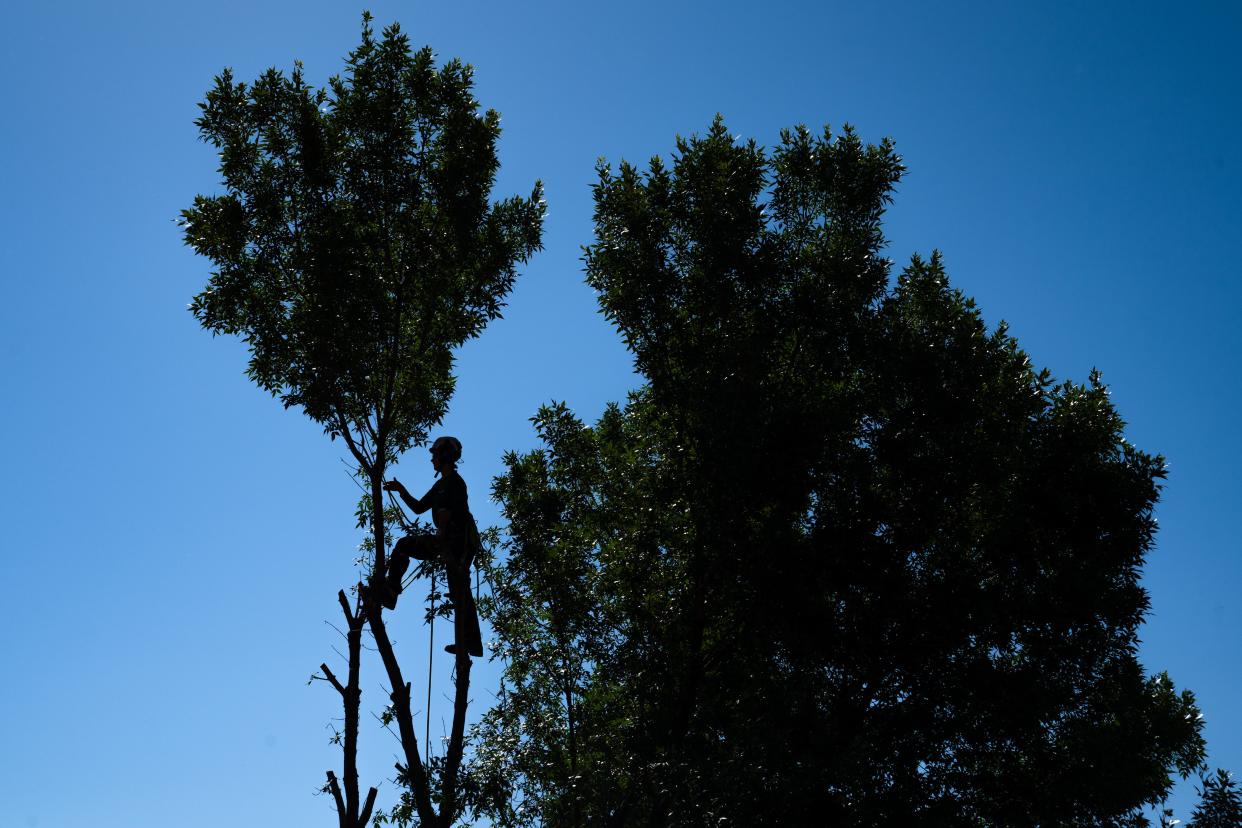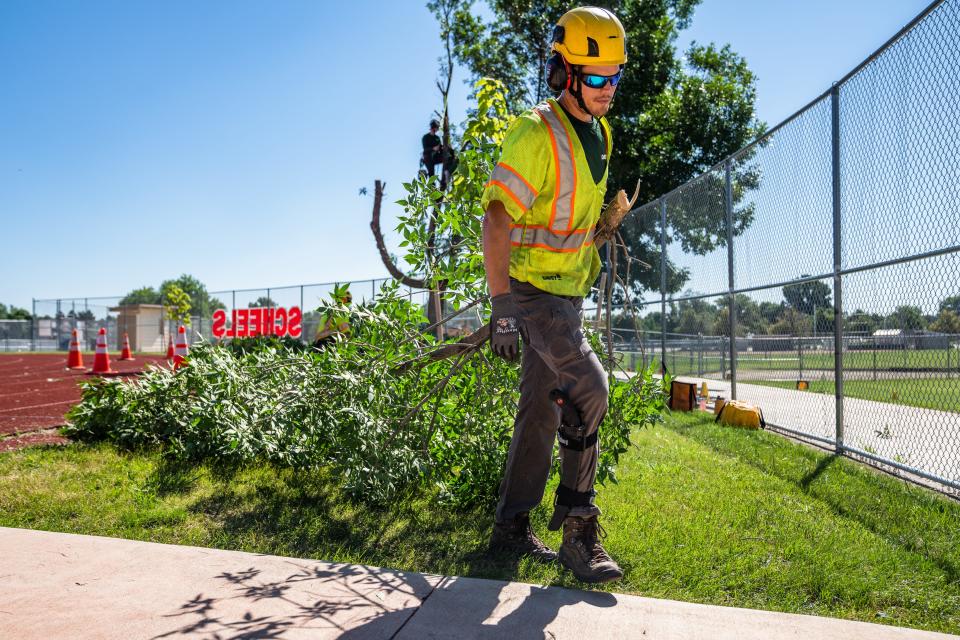Emerald ash borer spreading slower than expected in Fort Collins due to prevention efforts

Ash trees continue to be removed from public spaces in and around Fort Collins in an effort to slow the spread of the emerald ash borer.
A stand of trees south of the football field at Fort Collins High School, where the cross-country team’s athletes used to stand in the shade to meet and stretch before workouts, was recently reduced from about a dozen trees to two. About 70 other ash trees around the school, including some along Timberline Road, were also removed, according to a spreadsheet shared with the Coloradoan on Tuesday by Poudre School District.
None of those trees, all ash, had been infected by the invasive bug yet, but none met the district’s requirements for treatment every three years for about $500 per treatment, either, said Jeff Connell, PSD's chief operations officer.
“Our plan is to be proactive and shadow plant, remove and replace all ash trees that we are not planning to treat, so as to prevent the spread of the disease and provide a variety of replacement trees as soon as possible,” Connell said.
Funding for the district's seven-year emerald ash borer management plan was approved by the Poudre School District Board of Education in 2020, a spokesperson said.
PSD is not alone in its approach to dealing with the emerald ash borer, which has taken a heavy toll on ash trees throughout the eastern United States over the past two decades and, more recently, in Boulder and Longmont.
Colorado State University and the city of Fort Collins have also identified and are treating ash trees that meet their criteria for saving while preemptively cutting those that don’t and shadow-planting trees of a variety of other species nearby to replace them.
Ash trees made up about 15% of all trees in Fort Collins and provided 33% of the city’s canopy when the emerald ash borer was first detected locally three years ago, said Ralph Zentz, assistant forester for the city of Fort Collins.
How fast is the insect spreading and infecting our ash trees?
The spread of the emerald ash borer has been slower locally than in other parts of the country. Alison O’Connor, a professor of horticulture with CSU Extension Services in Larimer County, said there is speculation that some of the late spring freezes we’ve had in recent years have killed emerging adults.
The proactive approach the city of Fort Collins, CSU and PSD has taken to slow the spread have likely had an impact, too.
“Larimer County has had time to prepare for this insect, unlike Boulder County, which was the first confirmation back in 2013,” O’Connor said via email. “We’ve had 10 years of being able to plan, remove trees, replace trees, and also get recommendations/education for Larimer County residents.”
Will the emerald ash borer eventually kill all ash trees in our area?
No, O’Connor said.
Trees in fair and good condition that are treated before the insect has had time to take hold can be saved.
“If (a homeowner has) a mature ash and they have some signs of die-back and someone finds evidence of the emerald ash borer, the tree’s not a goner,” said Scott Simonds, CSU's campus arborist and horticulture supervisor. “If the canopy is less than 30% gone, you can treat that tree and save it.”
All untreated ash trees will likely become infected and die, Zentz said.
He suggested homeowners take the same approach as the city, CSU and PSD and treat large healthy ash trees against the emerald ash borer while removing and replacing smaller ones with trees of other species.
“Treatment will be a lifelong commitment,” O’Connor wrote, and suggested that property owners with trees they believe are worth saving hire a professional arborist or tree care professional to administer treatments. The products available to individual homeowners, she said, are not as effective against the emerald ash borer as those used by professional contractors.
Which trees are being removed?
About 800 ash trees have been removed on city-owned land, Zentz said. Those trees were primarily those in poor condition or already dead, he said.
The city is no longer preemptively removing ash trees that have not shown signs of infection, he said, because of the slower-than-expected progression of the emerald ash borer in the area.
“We haven’t really changed our plan,” he said. “We’re just implementing it at a slower rate.”
CSU has removed 293 of the 672 ash trees it identified for removal since 2017 and will continue to remove the other 379 over the next few years, Simonds said.
PSD removed 134 trees from its four comprehensive high schools in Fort Collins — Fort Collins (79), Fossil Ridge (45), Poudre (7) and Rocky Mountain (3) — this summer during the first phase of its removal plan, and plans to remove about 150 per year, Connell said. No ash trees were planted at the district’s new middle-high schools in Timnath and Wellington that opened last fall.

Which trees are being treated?
The criteria for which ash trees qualify for treatment vary among each entity. Generally, they’re older, thicker trees in good overall health.
The city has treated about 2,100 ash trees in the past three years, Zentz said, while working from north to south on a rotation that will be repeated every three years. The first confirmed emerald ash borer locally was found in a tree on private land near the intersection of U.S. Highway 287 and Colorado Highway 1 in north Fort Collins.
Ash trees with trunks that are 12 inches in diameter and in fair or better condition qualify for treatment, Zentz said.
CSU is treating healthy ash trees with trunks of 16 inches in diameter or larger, Simonds said, which represents roughly one-third of the ash trees on the university’s main, South and Foothills campuses.
PSD identified 111 large, healthy ash trees for treatment through a tree audit in 2018, performed with the Colorado State Forestry Service. Treatments on those trees began in 2020, and they were pruned in 2022, the data provided by the district shows.
“This cost can add up quickly, so we are very selective on the few trees that would qualify for treatment,” Connell wrote.
A contractor working for the district, The Davey Tree Expert Co., removed one of three mature ash trees behind the south end zone of French Field at Rocky Mountain High School on Tuesday. That particular tree was showing signs of weakness in its main trunk in the middle. Two other mature ash trees nearby, both about 35 feet tall and in good health, are being treated to save, a district spokesperson said.

How are the trees being saved treated?
The most effective form of treatment for larger ash trees has been trunk injections, said CSU extension's O’Connor. An insecticide, either emamectin benzoate or azadiractin, is injected into the trunk at the base of the tree to kill any emerald ash borers in the tree and protect it from new insects, she said. Treatments must be repeated every two to three years.
The city of Fort Collins, CSU and PSD are all using trunk injections, administered by trained contractors to avoid damaging the tree, to protect the ash trees they hope to save on the properties they manage.
Other forms of treatment include soil applications and trunk sprays, O’Connor said. Those treatments must be repeated annually.
“Treatment will be a lifelong commitment” regardless of the method selected, she said.
Property owners with ash trees adjacent to their properties in the city right of way that they would like to save that are not on the city’s list for preservation, can apply for a permit to treat those trees themselves, Zentz said. The permits, he said, help ensure that the city won’t accidently remove a tree the property owner has been treating.
When are replacement trees planted?
All three entities — the city, CSU and PSD — have been actively addressing the emerald ash borer for the past seven to 10 years, officials with each said.
Inspections of trees to determine which could and should be saved began in 2014, and shadow-planting of replacements has been taking place to replace those that wouldn’t be saved for the past seven to eight years.
PSD shadow-planted 144 trees across the district last fall and will plant 76 more at the four comprehensive high schools in Fort Collins through a contract with SuperTrees Colorado, officials said. Eighty-seven of the replacement trees are being planted at Fossil Ridge, 68 at Fort Collins High, nine at Poudre and four at Rocky Mountain, including two planted last fall about 15-20 feet on each side of the ash that was removed Tuesday.
What species of trees are being planted as replacements?
The city of Fort Collins, CSU and PSD are all trying to diversify the types of trees they plant in an effort to prepare for whatever the next insect or disease might be, officials said.
“The goal that we’re all shooting for, us and the city, is no more than 5% of the total canopy of any one species,” Simonds said. “That way, we don’t have a monoculture and have problems with this sort of thing happening in the future.”
PSD has been working closely with the city and CSU in its approach to the emerald ash borer, Connell and others said. All three entities are working from similar lists of species for replacement.
For example, the ash trees removed at Fort Collins High are being replaced with hardy rubber trees, swamp white oaks, state street maples, cobblestone burr oaks, emerald sunshine elms, shingle oaks, Turkish filberts and Valley Forge elms, Connell wrote.
Reporter Kelly Lyell covers education, breaking news, some sports and other topics of interest for the Coloradoan. Contact him at kellylyell@coloradoan.com, twitter.com/KellyLyell or facebook.com/KellyLyell.news.
This article originally appeared on Fort Collins Coloradoan: The emerald ash borer's spread in Fort Collins is slowing. Here's why.
